| |||||
| Decades: | |||||
|---|---|---|---|---|---|
| See also: | Other events of 1925 List of years in Egypt | ||||
Events in the year 1925 in Egypt .
| |||||
| Decades: | |||||
|---|---|---|---|---|---|
| See also: | Other events of 1925 List of years in Egypt | ||||
Events in the year 1925 in Egypt .
| | This section is empty. You can help by adding to it. (April 2023) |
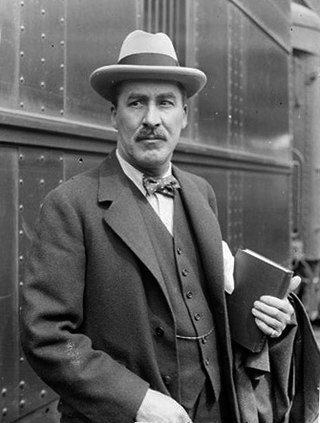
Howard Carter was a British archaeologist and Egyptologist who discovered the intact tomb of the 18th Dynasty Pharaoh Tutankhamun in November 1922, the best-preserved pharaonic tomb ever found in the Valley of the Kings.

Tutankhamun was the antepenultimate pharaoh of the Eighteenth Dynasty of ancient Egypt. He ascended to the throne around the age of nine and reigned until his death around the age of nineteen. The most significant actions of his reign were reversing the societal changes enacted by his predecessor, Akhenaten, during the Amarna Period: Tutankhamun restored the traditional polytheistic form of ancient Egyptian religion, undoing the religious shift known as Atenism, and moved the royal court away from Akhenaten's capital, Amarna. Tutankhamun was one of few kings worshipped as a deity during his lifetime; this was usually done posthumously for most pharaohs. In popular culture, he is known for his vastly opulent wealth found during the 1922 discovery of his tomb, KV62, the only such tomb to date to have been found in near-intact condition. The discovery of his tomb is widely considered one of the greatest archaeological discoveries of all time.

George Edward Stanhope Molyneux Herbert, 5th Earl of Carnarvon,, styled Lord Porchester until 1890, was an English peer and aristocrat best known as the financial backer of the search for and excavation of Tutankhamun's tomb in the Valley of the Kings.

Fuad I was the Sultan and later King of Egypt and the Sudan. The ninth ruler of Egypt and Sudan from the Muhammad Ali dynasty, he became Sultan in 1917, succeeding his elder brother Hussein Kamel. He replaced the title of Sultan with King when the United Kingdom unilaterally declared Egyptian independence in 1922.

The tomb of Tutankhamun, also known by its tomb number, KV62, is the burial place of Tutankhamun, a pharaoh of the Eighteenth Dynasty of ancient Egypt, in the Valley of the Kings. The tomb consists of four chambers and an entrance staircase and corridor. It is smaller and less extensively decorated than other Egyptian royal tombs of its time, and it probably originated as a tomb for a non-royal individual that was adapted for Tutankhamun's use after his premature death. Like other pharaohs, Tutankhamun was buried with a wide variety of funerary objects and personal possessions, such as coffins, furniture, clothing and jewelry, though in the unusually limited space these goods had to be densely packed. Robbers entered the tomb twice in the years immediately following the burial, but Tutankhamun's mummy and most of the burial goods remained intact. The tomb's low position, dug into the floor of the valley, allowed its entrance to be hidden by debris deposited by flooding and tomb construction. Thus, unlike other tombs in the valley, it was not stripped of its valuables during the Third Intermediate Period.

Tomb KV60 is an ancient Egyptian tomb in the Valley of the Kings, Egypt. It was discovered by Howard Carter in 1903, and re-excavated by Donald P. Ryan in 1989. It is one of the more perplexing tombs of the Theban Necropolis, due to the uncertainty over the identity of one female mummy found there (KV60A). She is identified by some, such as Egyptologist Elizabeth Thomas, to be that of the Eighteenth Dynasty pharaoh Hatshepsut; this identification is advocated for by Zahi Hawass.

Harry Burton was an English archaeological photographer, best known for his photographs of excavations in Egypt's Valley of the Kings. Today, he is sometimes referred to as an Egyptologist, since he worked for the Egyptian Expedition of the Metropolitan Museum of Art for around 25 years, from 1915 until his death. His most famous photographs are the estimated 3,400 or more images that he took documenting Howard Carter's excavation of Tutankhamun's tomb from 1922 to 1932.
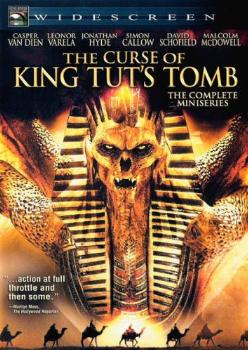
The Curse of King Tut's Tomb is a 2006 adventure fantasy horror television film directed by Russell Mulcahy and starring Casper Van Dien, Leonor Varela, and Jonathan Hyde.
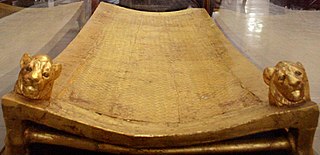
Exhibitions of artifacts from the tomb of Tutankhamun have been held at museums in several countries, notably the United Kingdom, Soviet Union, United States, Canada, Japan, and France.

The curse of the pharaohs or the mummy's curse is a curse alleged to be cast upon anyone who disturbs the mummy of an ancient Egyptian, especially a pharaoh. This curse, which does not differentiate between thieves and archaeologists, is claimed to cause bad luck, illness, or death. Since the mid-20th century, many authors and documentaries have argued that the curse is 'real' in the sense of having scientifically explicable causes such as bacteria or radiation. However, the modern origins of Egyptian mummy curse tales, their development primarily in European cultures, the shift from magic to science to explain curses, and their changing uses—from condemning disturbance of the dead to entertaining horror film audiences—suggest that Egyptian curses are primarily a cultural, not scientific, phenomenon.
Percy Edward Newberry was a British Egyptologist.
The Curse of King Tut's Tomb is a 1980 horror film directed by Philip Leacock and starring Eva Marie Saint, Harry Andrews, Raymond Burr and Tom Baker, with Paul Scofield as the narrator.
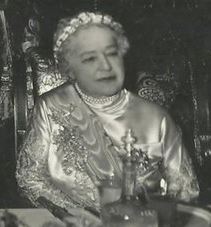
Melek Hassan Tourhan was the second wife of Sultan Hussein Kamel of Egypt. After her husband ascended the throne in 1914, she became known as Sultana Melek.
Tutankhamun's mummy was discovered by English Egyptologist Howard Carter and his team on October 28, 1925 in tomb KV62 of Egypt's Valley of the Kings. Tutankhamun was the 13th pharaoh of the 18th Dynasty of the New Kingdom of Egypt, making his mummy over 3,300 years old. Tutankhamun's mummy is the only royal mummy to have been found entirely undisturbed.

Arthur Cruttenden Mace was a Tasmanian-born English archaeologist and Egyptologist. He is best known for his work for the New York Metropolitan Museum, and as a part of Howard Carter's team during the excavation of Tutankhamun's tomb.
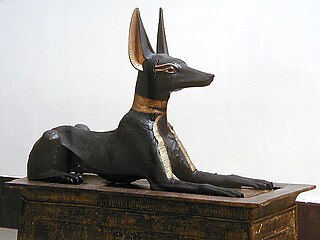
The Anubis Shrine was part of the burial equipment of the 18th Dynasty pharaoh Tutankhamun, whose tomb in the Valley of the Kings was discovered almost intact in 1922 by Egyptologists led by Howard Carter. Today the object, with the find number 261, is on display at the Egyptian Museum in Cairo, with the inventory number JE 61444.

The mask of Tutankhamun is a gold funerary mask of the 18th-dynasty ancient Egyptian pharaoh Tutankhamun. After being buried for over 3,000 years, it was excavated by Howard Carter in 1925 from tomb KV62 in the Valley of the Kings and is now in the Egyptian Museum in Cairo. The death mask is one of the best-known works of art in the world and a prominent symbol of ancient Egypt.

Lady Evelyn Leonora Almina Beauchamp, always known to the family as Eve, was the daughter of George Herbert, 5th Earl of Carnarvon. In November 1922, she, her father and the archaeologist Howard Carter were the first people in modern times to enter the tomb of the Egyptian Pharaoh Tutankhamun. She later married Sir Brograve Beauchamp and had a daughter. Lady Evelyn died in 1980, at the age of 78.

Albert Morton Lythgoe was an American archaeologist and Egyptologist. He is best known for his work for the New York Metropolitan Museum of Art, and for the support he gave to the excavation of Tutankhamun's tomb, he releasing several key Metropolitan Museum staff to assist Howard Carter.

The tomb of Tutankhamun was discovered in the Valley of the Kings in 1922 by excavators led by the Egyptologist Howard Carter. Whereas the tombs of most pharaohs were plundered by graverobbers in ancient times, Tutankhamun's tomb was hidden by debris for most of its existence and therefore not extensively robbed. It thus became the first known largely intact royal burial from ancient Egypt. To date, the discovery of Tutankhamun's tomb is widely considered one of the most famous archaeological discoveries of all time.